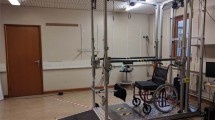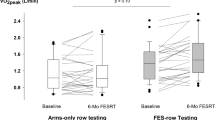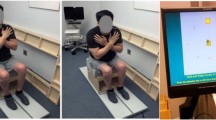Abstract
Study design:
Single case cross-over design with multiple baselines.
Objective:
To compare two functional electrical stimulation (FES) training protocols to assist sit-to-stand in people with incomplete spinal cord injury (SCI).
Setting:
The study was conducted in Sydney, Australia.
Methods:
Four subjects with incomplete SCI undertook nine sessions of FES supported cycling at either 100 or 35 Hz stimulus frequency repeated. Ground reaction force and rate of generation of vertical ground reaction force during standing from sitting were measured before and after each training series.
Results:
Subjects improved their ability to generate greater support through the feet after training with 35 Hz stimulus paradigm but increased the rate of force production after training with 100 Hz stimulation.
Conclusions:
Different FES training paradigms appear to produce different responses; however the ability to stand up seems more responsive to training with 35 Hz FES stimulation.
Similar content being viewed by others
Main
Functional electrical stimulation (FES) has been used for 50 years to obtain controlled contraction of paralyzed muscle,1 particularly after spinal cord injury (SCI).2 FES has been reported to increase muscle cross-sectional area3 and assist functional activities.4 As SCI leads to rapid and extensive muscle atrophy5 with reduction in power generation capacity,6 such therapeutic benefits may be important. Although between 65 and 70% of SCI are classified as incomplete lesions (iSCI),7 the diversity of motor loss and sparing means that the functional prognosis for such people may be little better than for those with complete lesions.8
Standing and walking are typical rehabilitation priorities for people with SCI. However, to stand up from a chair requires considerable strength and power,9 in particular from the hip and knee extensor muscles. The use of FES to assist such activities has some currency in iSCI10 and FES-assisted cycling and resisted exercise have been shown to improve muscle strength.3, 11 Whether such training can elicit sufficient muscle strength and power to restore sit-to-stand ability in people with iSCI has not been reported.
Most studies using FES in this manner employ a stimulation frequency of 35 Hz.12 However, a number of studies have suggested that an enhanced effect on muscle contraction may be obtained through the use of electrical stimuli at higher frequencies up to 100 Hz,13, 14, 15 which produce synaptic recruitment of spinal motoneurons16 and recruit a greater number of fatigue resistant motor units through reflex activation of smaller motoneurons,17 but there have been no reported studies in which training using stimulation frequencies of 35 and 100 Hz have been compared in terms of their benefits to functional activity such as standing from sitting.
This exploratory investigation involved a repeated series of single case studies using a cross-over design with a randomized order of training to compare 100 Hz, high frequency (HF) and 35 Hz, standard frequency (SF) stimulation protocols and their effects on recovery of standing up.
Materials and methods
Participants
Participants were recruited from among community-living people with iSCI in Sydney, Australia. Inclusion criteria were: (i) having sustained a SCI at least 1 year before the commencement of the study resulting in incomplete paralysis (classification ASIA C or D); (ii) being aged between 18 and 65; (iii) having no other medical problems likely to influence test performance (for example, old fractures, contractures, newly formed decubitus ulcers); and (iv) being able to tolerate levels of FES sufficient to produce knee extension.
Body mass, height, gender and age were recorded as was the manual muscle test scores for the knee and hip extensors (Table 1). All participants gave written informed consent to the testing procedures and data were de-identified and coded. Institutional approval was granted for this study (ref no.: 04-2008/10769).
Test protocol
A custom-designed transcutaneous neuromuscular stimulator18 generating square wave, monophasic pulses of width 300 μs, at frequencies of either 35 Hz (SF) or 100 Hz (HF) was employed. Monophasic pulse was used because the stimulator did not have the capacity to deliver 100 Hz stimulation with biphasic pulses. Skin-surface, self-adhesive electrodes (13 × 5 cm; StimCare Carbon FM Electrodes, Medi-Stim Inc., Wabasha, MN, USA) were placed bilaterally over the proximal antero-lateral and distal antero-medial surfaces of the quadriceps femoris muscle and over the proximal and distal ends of the gluteus maximus muscle. Stimulation amplitudes were set according to individual tolerance and requirement to achieve knee and hip extension. This amplitude was determined through a number of practices before each test session. Details of stimulation intensities are included in Table 2.
Subjects sat in a chair with each foot on a force platform (AMTI, Watertown, MA, USA) and with a set of parallel bars positioned such that they could use these for balance or to assist them to stand if required. On a verbal cue, subjects were told to attempt to stand up and stimulation was applied to the knee and hip extensors. A total of five trials were performed, with a rest period of 2 min between each trial. SF and HF tests were conducted on different days, at the same time of day. Subjects were protected, but not supported, by a harness attached to an overhead beam throughout the test.
Training protocol
Before training, all subjects were tested using the above protocol. Subjects were randomly assigned to receive training using either HF or SF stimulation for three sessions per week for 3 weeks. This was followed by a repeat of the test protocol and a cross-over in which they received the alternative stimulation protocol for the same training for a further nine sessions, after which they were again tested.
Each subject participated in FES-supported, semi-recumbent cycling using a motorized cycle ergometer and a muscle stimulator.18 The quadriceps, hamstrings and glutei were stimulated via monophasic, rectangular pulses with a pulse width of 300 μs over preset angles during the pedaling cycle, which was conducted at a cadence of 50 r.p.m. Consistency of muscle fiber recruitment was ensured through the use of key anatomical landmarks to ensure similar electrode placement. The maximum stimulation amplitude was manually incremented as muscles fatigued and was limited to 140 mA. Each training session lasted 45 min. Subjects also underwent a training program consisting of three sets of eight repetition maximum resistance weights applied to the knee and hip extensors with FES support. Adequate rest periods were given to allow recovery between exercise sessions.
Data capture and analysis
The ground reaction force (Fgr) under the subject’s feet was collected in real-time at 100 Hz. This gives a measure of the extent to which the subject was able to achieve independent standing. The difference between the value of Fgr and the subject’s body weight is a proxy for the amount of force transmitted through the hands. Maximum Fgr was calculated for each trial at each test session.
Because power is necessary to achieve standing9 and this is a function of the rate at which force can be generated, the instantaneous first derivative of Fgr (δFgr/δt) was calculated and the peak value during the rise to stand recorded (Figure 1).
In light of the single case design of the investigation, no inferential statistical analysis was conducted. Determination of the stability of observations was established through reporting of the coefficient of variance for the five trials at each test session for maximum Fgr and maximum δFgr/δt.
Results
Four suitable subjects were recruited to the study. All had similar impairments of the lower limb extensor muscles (Table 1) but were sensate and able to tolerate FES stimulation sufficient to achieve a strong contraction of the relevant muscle groups. No adverse events were recorded during training or testing.
General
In all cases we observed no apparent difference between the maxima for Fgr and δFgr/δt in response to different stimulation protocols at the initial, baseline test sessions. We also noted that, in none of the subjects, was the maximum Fgr value apparently different at different test periods between the two stimulation patterns. The intensity of stimulation required during testing, although determined by the individual’s tolerance and ability to achieve contraction, was slightly lower in the HF stimulation in the case of Subjects A and D (Table 2), however these differences were relatively small and were not seen in subjects B and C. The mean stimulation intensities during training were effectively identical between SF and HF for each individual.
Subject A (Figures 2a and 3a)
Individual responses of four subjects with respect to rate of ground reaction force generation. Subjects labelled according to text. Training periods indicated according to Figure 2. Key: upward triangle—HF δFgr/δt; downward triangle—SF δFgr/δt.
Training: SF→HF.
Both maximum Fgr and δFgr/δt increased in response to the first training, but Fgr decreased slightly after the second training period, although δFgr/δt continued to increase, in particular when HF stimulation was applied.
Subject B (Figures 2b and 3b)
Training: HF→SF.
Following his first training period we observed no apparent change in either maximum Fgr or δFgr/δt. Subsequently, following the second training, we noted a substantial improvement in both maximum Fgr and δFgr/δt but the responses did not seem to be determined by the stimulation frequency during the test.
Subject C (Figures 2c and 3c)
Training: HF→SF.
As with Subject B, she demonstrated no apparent change in either maximum Fgr or δFgr/δt between pre-training and the conclusion of the first training period. However, after the second training period (with SF stimulation) there was a noticeable increase in both variables.
Subject D (Figures 2d and 3d)
Training: SF→HF.
At initial testing and during subsequent tests, HF stimulation elicited a stronger response in terms of force generation (δFgr/δt), but not with respect to maximum Fgr. After the first training period there were apparent increases in both variables, however after the second training period no further increase in ability to sustain weight-bearing was noted, although some further increase in rate of force generation with HF stimulation was observed.
Discussion
This small case series raises a number of interesting findings. We initially sought to compare HF and SF stimulation protocols, both in terms of their immediate effect and with regard to their efficacy in FES-based strength training. There was no obvious difference between the two stimulus frequencies with respect to the absolute force generated by the extensor muscles, assuming that Fgr can be considered a valid proxy for this (Figure 2), although there were variable responses from the subjects with regard to current intensity with different frequency modes. However, it did appear that the HF stimulation was somewhat more effective in producing a more rapid force generation (δFgr/δt) than SF, particularly after training.
The use of HF training does not appear to produce any clear gains in maximum force generating capacity. In cases where this was the first training strategy (Subjects B and C), participants showed no change in performance after nine training sessions, but then responded positively to training with SF. When SF was the first training medium, there was a positive response (Subjects A and D) but this did not continue when HF training was applied. With respect to rate of force generation, however, training with either HF or SF stimulation did seem to improve performance, irrespective of the order of stimulation, and gains tended to continue over the two training periods. The specificity of cycling training could potentially limit the transferability of any strength gains to the functional task of standing up, although one might expect that the inclusion of weight resistance training would offset this to some extent. FES-supported cycling is, however, a very common training modality in rehabilitation of people with iSCI, so we feel that our training protocol was contextually valid. There is no clear indication whether the nine training sessions represented an optimal dose; the number of sessions was determined on a pragmatic basis as being within a manageable time frame for participants. Similarly, there was no ‘wash-out’ period factored into the protocol as this was deemed impractical and largely incalculable in these subjects. Therefore, some carry-over effects might be expected from one training period to the other, although the random cross-over order might reduce this to some extent.
Our preliminary conclusion, based on these results, is that the use of 100 Hz stimulation during cycling and weight resistance training does not appear to achieve functionally significant gains in the maximum force that can be generated by the trained muscles, whereas using the conventional 35 Hz does seem to effect an improvement. On the other hand, 100 Hz stimulation, as a discrete entity, does seem to improve the rate of muscle force generation to a greater extent than 35 Hz, particularly after a period of training.
Study limitations
The relative stability of the observations at each interval for each subject encourages us to believe that the findings of this study are valid for the subjects tested. Clearly there is need for further investigation of these phenomena in light of our findings. We believe, however, that the repetition of a single case, cross-over design has provided a useful insight into the effect of FES-supported training on the performance of standing from sitting in a population notoriously difficult to investigate.
References
Liberson WT, Holmquest HJ, Scott D, Dow M . Functional electrotherapy, stimulation of the peroneal nerve synchronized with the swing phase of the gait of hemiplegic patients. Arch Phys Med Rehabil 1961; 42: 101–105.
Raymond J, Crameri R . Electrical stimulation for individuals with spinal cord injury. Am J Med Sports 2001; 3: 209–222.
Mahoney ET, Bickel CS, Elder C, Black C, Slade JM, Apple D et al. Changes in skeletal muscle size and glucose tolerance with electrically stimulated resistance training in subjects with chronic spinal cord injury. Arch Phys Med Rehabil 2005; 86: 1502–1504.
Klose K, Jacobs P, Broton J, Guest RS, Needham-Shropshire BM, Lebwohl N et al. Evaluation of a training program for persons with SCI paraplegia using the Parastep ambulation system: part 1. Ambulation performance and anthropometric measures. Arch Phys Med Rehabil 1997; 78: 789–793.
Castro MJ, Apple DF Jr, Hillegass EA, Dudley GA . Influence of complete spinal cord injury on skeletal muscle cross-sectional area within the first 6 months of injury. Eur J Appl Physiol 1999; 80: 373–378.
Herbison GJ, Zerby SA, Cohen ME, Marino RJ, Ditunno JF . Motor power differences within the first two weeks post SCI in cervical spinal cord injured quadriplegic subjects. J Neurotrauma 1992; 9: 373–380.
Norton L . Spinal Cord Injury, Australia 2007–08, Injury research and statistics series no. 52 AIHW: Canberra. 2010.
Kroll T, Neri MT, Ho PS, Kroll T, Neri MT, Ho P-S . Secondary conditions in spinal cord injury: results from a prospective survey. Disab Rehabil 2007; 29: 1229–1237.
Lindemann U, Claus H, Stuber M, Augat P, Muche R, Nikolaus T et al. Measuring power during the sit-to-stand transfer. Eur J Appl Physiol 2003; 89: 466–470.
Nightingale EJ, Raymond J, Middleton JW, Crosbie J, Davis GM . Benefits of FES gait in a spinal cord injured population. Spinal Cord 2007; 45: 646–657.
Reichenfelser W, Hackl H, Hufgard J, Kastner J, Gstatlner K, Gfohler M . Monitoring of spasticity and functional ability in individuals with incomplete spinal cord injury with a functional electrical stimulation cycling system. J Rehabil Med 2012; 44: 444–449.
Hjeltnes N, Aksnes AK, Birkeland KI, Johansen J, Lannem A, Wallberg-Henriksson H . Improved body composition after 8 wk of electrically stimulated leg cycling in tetraplegic patients. Am J Physiol 1997; 273: R1072–R1079.
Nickolls P, Collins DF, Gorman RB, Burke D, Gandevia SC . Forces consistent with plateau-like behaviour of spinal neurons evoked in patients with spinal cord injuries. Brain 2004; 127: 660–670.
Matsunaga T, Shimada Y, Sato K . Muscle fatigue from intermittent stimulation with low and high frequency electrical pulses. Arch Phys Med Rehabil 1999; 80: 48–53.
Eser PC, Donaldson NdN, Knecht H, Stussi E . Influence of different simulation frequencies on power output and fatigue during FES-cycling in recently injured SCI people. IEEE Trans Neural Systems Rehabil Engin 2003; 11: 236–240.
Collins DF . Central contributions to contractions evoked by tetanic neuromuscular electrical stimulation. Exerc Sport Sci Rev 2007; 35: 102–109.
Harrison PJ, Taylor A . Individual excitatory post-synaptic potentials due to muscle spindle Ia afferents in cat triceps surae motoneurones. J Physiol 1981; 312: 455–470.
Fornusek C, Davis GM, Sinclair PJ, Milthorpe B . Development of an isokinetic functional electrical stimulation cycle ergometer. Neuromodulation 2004; 7: 56–64.
Acknowledgements
This project was supported by National Health and Medical Research Council Project Grant #5512351. Ms Tanhoffer was a masters candidate and had been awarded a Postgraduate Scholarship in Clinical Rehabilitation Sciences, Faculty of Health Sciences, The University of Sydney. The contributions of Associate Professor Jane Butler of Neuroscience, Australia and Professor Glen Davis and Associate Professor James Middleton of the University of Sydney are acknowledged with gratitude.
Author information
Authors and Affiliations
Corresponding author
Ethics declarations
Competing interests
The authors declare no conflict of interest.
Rights and permissions
About this article
Cite this article
Crosbie, J., Tanhoffer, A. & Fornusek, C. FES assisted standing in people with incomplete spinal cord injury: a single case design series. Spinal Cord 52, 251–254 (2014). https://doi.org/10.1038/sc.2013.158
Received:
Revised:
Accepted:
Published:
Issue Date:
DOI: https://doi.org/10.1038/sc.2013.158
Keywords
This article is cited by
-
Functional electrical stimulation cycling exercise after spinal cord injury: a systematic review of health and fitness-related outcomes
Journal of NeuroEngineering and Rehabilitation (2021)






